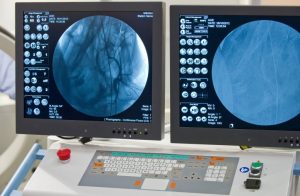A new kind of precise and non-invasive imaging called optical coherence tomography angiography (OCTA) has assisted much of the recent research on the eye’s connection with Alzheimer’s. It enables physicians to see the smallest veins in the back of the eye, including the red blood cells moving through the retina.
 Researches at Duke University in Durham, North Carolina say that Alzheimer’s could be diagnosed in seconds by simply looking at a person’s eyes. Scientists at the Sheba Medical Center in Israel, concur.
Researches at Duke University in Durham, North Carolina say that Alzheimer’s could be diagnosed in seconds by simply looking at a person’s eyes. Scientists at the Sheba Medical Center in Israel, concur.
Results from two studies show that a new, non-invasive imaging device can see signs of Alzheimer’s disease in a matter of seconds. The researchers show that the small blood vessels in the retina at the back of the eye are altered in patients with Alzheimer’s. Even patients who have a family history of Alzheimer’s but have no symptoms show these telltale signs. And they showed that they can distinguish between people with Alzheimer’s and those with only mild cognitive impairment.
Because the retina is connected to the brain by way of the optic nerve, researchers believe that the deterioration in the retina and its blood vessels may mirror the changes going on in the blood vessels and structures in the brain, thereby offering a window into the disease process.
The world’s population is aging rapidly, and the prevalence of Alzheimer’s is on the rise. For this reason, the need for efficient dementia screening methods that can be applied to millions of people is dire. Current diagnostic practices are either invasive or ineffective.
Some techniques can detect signs of the disease but are impractical for screening millions of people: Brain scans are expensive and spinal taps can be harmful. Instead, the disease is often diagnosed through memory tests or observing behavior changes. By the time these changes are noticed, the disease is advanced. Even though there is no cure, early diagnosis is critical as future treatments are likely to be most effective when given early. Early diagnosis would also give patients and their families time to plan for the future.
The goal of this latest research is to find a quick, inexpensive way to detect Alzheimer’s at the earliest signs.
The researchers at Duke University used OCTA to compare the retinas of Alzheimer’s patients with those of people with mild cognitive impairment, as well as healthy people. They found that the Alzheimer’s group had loss of small retinal blood vessels at the back of the eye and that a specific layer of the retina was thinner. Even people with mild cognitive impairment did not show these changes.
Ophthalmologist and lead author Sharon Fekrat, M.D., professor of Ophthalmology at Duke, along with colleague Dilraj Grewal M.D., associate professor of Ophthalmology at Duke, and their research team expect that their work will have a positive impact on patient’s lives.
“This project meets a huge unmet need,” Dr. Fekrat said. “It’s not possible for current techniques like a brain scan or lumbar puncture (spinal tap) to screen the number of patients with this disease. Almost everyone has a family member or extended family affected by Alzheimer’s. We need to detect the disease earlier and introduce treatments earlier.”
Likewise, Ygal Rotenstreich M.D., an ophthalmologist at the Goldschleger Eye Institute at Sheba Medical Center said, “A brain scan can detect Alzheimer’s when the disease is well beyond a treatable phase, we need treatment intervention sooner. These patients are at such high-risk.”
Optical coherence tomography angiography lets ophthalmologists examine each of the retina’s layers, mapping them and measuring their thickness noninvasively. The technique uses light waves to take photos of the retina.
To ensure that the equipment used is yielding the best images possible, it’s imperative to have a high-precision lens that delivers an exact look at the retina. Universe Kogaku designs and manufactures optical lenses for medical, automated agricultural equipment, security, high tech and electronic applications. We stock 1000’s of standard lens assemblies and can custom design a solution for scanners, CCTV, CCD/CMOS, medical imaging, surveillance systems, machine vision and night vision systems.